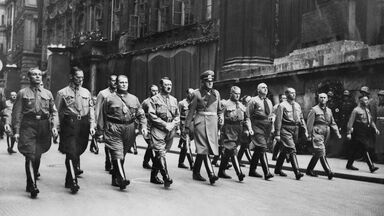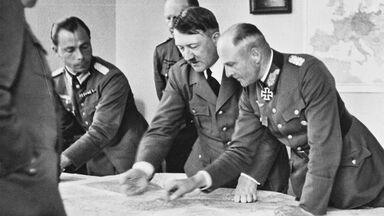What helped Adolf Hitler and the Nazi Party rise to power in the 1930s? answers
How Did Hitler Rise to Power? Timeline of Key Events
Many people wonder how Adolf Hitler was able to have control of Germany and the Nazi Political party before beginning Earth State of war Two. But how did Hitler rise to power so quickly? Yous may be surprised to learn that every step in Hitler'south rise to power was legal — and democratic. Read Hitler's rise to power timeline to larn how a series of events enabled a wounded veteran from Republic of austria to get i of the near infamous dictators in world history.
 Adolf Hitler Platz Nazi salute
Adolf Hitler Platz Nazi salute
Hitler'southward Entrance Into Politics
Despite existence born in Republic of austria, Adolf Hitler spent four years fighting in World State of war I in the German language Ground forces. He was temporarily blinded and mute from a mustard gas assault in 1918, just one month before Germany surrendered the war on Nov 10th. Hitler'southward outrage over Germany'due south loss — and the 1919 Treaty of Versailles, which placed the arraign for World State of war I on Germany — inspired him to pursue a life in politics.
1919: The German Worker's Party
In September 1919, Hitler joined the Deutsche Arbeiterpartei (the German Worker's Party, or DAP) afterward existence assigned to spy on information technology for the High german Army in June. He respected the party's opposition to the new Weimar Republic, the Treaty of Versailles and equal handling of Jews in Germany. Hitler quickly became i of the most prominent speakers of the political party.
1920: The National Socialist German Worker's Political party (NSDAP)
On February 24th, Hitler led a political meeting of over 2,000 people. He appear the nationalist Twenty-Five Point Program, also known as the National Socialist Plan, and officially renamed the party as the Nationalsozialistische Deutsche Arbeiterpartei (the National Socialist German Worker's Party), afterward known every bit the Nazi Party. Hitler besides began to speak in beer halls in Munich every bit a way to accomplish and recruit more people. His speaking and propaganda skills made him a popular effigy throughout Bavaria.
1921: Chairman of the NSDAP
Hitler threatened to resign from the NSDAP over the possibility of merging with the German Socialist Party. Every bit he was the party'due south nearly well-known and influential figure, the political party agreed non to merge with the rival party and to appoint Hitler political party chairman. He at present controlled the NSDAP, and led it into vehement conflicts against other High german political parties. Hitler formed the Sturmabteilung (Assault Division, as well known every bit the SA or Brownshirts).
1922: The Hitler Youth and the Staff Guard
Hitler established iii major organizations in 1922: the Jungsturm Adolf Hitler and the Jugendbund der NSDAP (the Hitler Youth) and the Stabswache (the Staff Guard, later the SS). He continued to speak against Jews and for the "victory of the Aryan" at political party rallies. In October, Hitler admired Benito Mussolini's Fascist insurrection d'état in Italy.
1923: Reichsparteitag and The Beer Hall Coup d'état
The commencement Reichsparteitag (Reich Party Convention, or Nuremberg Rally) took place in January 1923 in Munich. Later in the yr, Hitler attempted his own coup d'état in Nov 1923 during the Beer Hall Putsch, in which two,000 Nazis marched on the city center. Sixteen Nazis and four police force officers were killed. Hitler escaped but was arrested for high treason two days afterward. The incident gave Hitler a national profile.
1924: Mein Kampf and 1924 Elections
At his 1924 trial, Hitler was bedevilled and sentenced to v years in prison. He wrote Mein Kampf (My Struggle), a manifesto to the Nazi propaganda and anti-Semitism, during his imprisonment. Although the Nazi Political party was banned in Bavaria after the Beer Hall Coup d'état, information technology won a few seats in regime in the May and December High german federal elections. Hitler was released in December afterwards serving but nine months of his judgement.
1925: Legal Power Over Concrete Force

The failure of the Beer Hall Putsch and influence of Mussolini prompted Hitler to movement toward legal means of gaining power, rather than violence. Mein Kampf was published in July 1925, making Hitler famous in the European Fascist movement. Hitler formed the Schutzstaffel (SS) exterior the control of the SA. He formally renounced his Austrian Citizenship in 1924 as well.
Paul von Hindenburg was elected president of Germany. Joseph Goebbels joined the Nazi Party during this time period after reading Mein Kampf. He would later get Hitler's closest ally and the hereafter Minister of Propaganda of Nazi Germany.
The Rise of the Nazi Party
Hitler and the Nazi Political party were starting to gain some recognition outside Bavaria and throughout Federal republic of germany. During the rest of the 1920s, the party used anti-Semitic propaganda and Hitler'south popularity to movement into legitimate politics. They gained voters and seats in every federal election, causing the moderate parties to take notice — and alarm.
1928: May Federal Ballot
Federal elections were more than successful for the NSDAP than earlier, but nonetheless not strong: the Nazi Party won simply two.half dozen% of the vote. However, by the end of the year, the Nazi party included more 130,000 members.
1929: Presidential Ballot and Stock Market Crash
The Nazi candidate for president, Erich Ludendorff, ran for president and only won 1.one% of the vote. The New York Stock Market crash of Oct 29th led to a major financial disruption all over the world. Massive numbers of German citizens were at present unemployed and in financial distress.
The German language Referendum of 1929 was held in December. It renounced the Treaty of Versailles and disallowed German language officials to pay German war debts from World State of war I. Although the referendum ultimately failed, it gave the Nazi Party substantial recognition.
1930: Street Violence and Election Success
In 1930 there was an escalation of street violence instigated by the Nazis and propaganda past Goebbels. In the September federal election, Nazis won over 18% of the vote and gained 107 government seats. When combined with the Communists receiving almost 22% of the vote, the results of the election effectively locked out the more than moderate parties of Germany. The Nazis were at present the second-largest party in Germany.
Heinrich Brüning, Chancellor of Germany, attempted to alleviate fiscal pressure on Germany by invoking Article 48 of the German language Constitution. This immune the government to pass laws without the consent of the Reichstag, or parliamentary body.
1931: The Harzburg Front
Hitler joined a right-wing opposition to Chancellor Brüning called the Harzburg Front end. Information technology was an anti-autonomous effort to form a united front end confronting the moderate German government. However, the Nazis had no intention of joining forces with anyone; they wanted to be in control, with Hitler in control.
1932: Industrielleneingabe and Party Majority
The Nazi Party now had over 800,000 members. Hitler ran for president in the March 1932 presidential election and lost to President Hindenburg, but gained over 36% of the vote. In May, Chancellor Brüning was replaced past Franz von Papen in an effort by President Hindenburg to endeavour and end Hitler's political ascent.
The Nazis won over 37% of the popular vote in July 1932. They were now the largest party in the Reichstag, and as such, they chose Hermann Göring to be Reichstag President. Hitler asked to exist chancellor; when Chancellor Papen offered him the position of vice-Chancellor, Hitler refused.
In Nov, the Nazis received a lower per centum of the vote, but xix prominent members of the High german economy signed the Industrielleneingabe — a petition for President Hindenburg to make Hitler chancellor of Germany. In Dec, Chancellor Papen was replaced by Major-General Kurt von Schleicher, a rival of Hitler'southward. Papen made an agreement with Hitler that he could convince Hindenburg to make Hitler chancellor, as long as Hitler made Papen vice-chancellor.
Machtergreifung: Hitler Takes Ability
Past 1933, Hitler'due south political maneuvers would pay off for him and the Nazi Political party. The timing of the Great Depression helped Hitler'south cause, as millions of out-of-work Germans hung their hopes on Hitler's promises of prosperity. But a few years later, Hitler would pb Germany into World State of war 2 in the ultimate test of his power and of humanity itself.
1933: Hitler Becomes Chancellor
Hitler's Machtergreifung (seizure of ability) began when he was named chancellor in January 1933, thanks to Papen's influence and Hindenburg's agreement. His appointment sparked concern in both neighboring democracies and in the Jewish community. In February, the Reichstag was attacked past a Communist arsonist, leading to swift action confronting Hitler's political rivals.
Hitler gained plenary powers in March from the Enabling Act of 1933, which gave him the ability to act without limitations from the Reichstag or the German Constitution. Once Hitler had these dictatorial powers, he eliminated civil liberties and opportunities for opposition. Political parties that were not Nazi parties were made illegal in July. In October, Germany withdrew from the League of Nations and the World Disarmament Conference.
1934: Hitler Becomes Führer
During Nacht der langen Messer (Night of the Long Knives), Hitler instructed the SS to execute various political rivals and opponents, including leaders of the SA, which had get increasingly independent from Hitler's control. Because Hitler had plenary powers, he was able to order the killings without the consent of the courts. Over 150 people were murdered in the purge between June 30th and July second, and hundreds more were arrested.
On July third, Vice-Chancellor Papen resigned. President Hindenburg died a month subsequently. The day before he died, Hitler's cabinet enacted a constabulary that would cancel the part of the president, and that all powers of the president would be merged with the chancellor's upon Hinderburg'due south decease. This allowed Hitler to become Führer und Reichskanzler - leader and chancellor — and therefore caput of the government. Soldiers of the German Army took the Hitler Oath, swearing allegiance and obedience to Hitler himself instead of the state.
Earth War II

Every bit Führer, Hitler would get on to isolate Frg from the residual of the world, both politically and economically. He rearmed Germany in a violation of the Treaty of Versailles and began expanding Germany'southward borders by annexing Austria in 1938. By 1941, Hitler's army had invaded the Sudetenland, Czechoslovakia, Poland, Kingdom of denmark, Norway, Belgium, holland, Grand duchy of luxembourg, France, Yugoslavia, and Greece. His seige against Britain and the Soviet Union, along with the Japanese attack on the U.s., brought nearly every land in the world out in strength.
Under Hitler'south command, Nazi Germany established over 40,000 concentration camps and ghettos to detain, enslave and murder prisoners. These prisoners primarily included Jews from Germany and other invaded countries also every bit political opponents, homosexuals, Roma, and strange nationals. All told, Hitler's pursuit of power caused the deaths of 75 million people before his own death in 1945.
A Cautionary Tale for Democracy Everywhere
The results of Adolf Hitler'south rule were catastrophic and devastating to every community in the world. Still, he would never have been able to move up the ranks of the German government without the bankroll of his supporters and political allies. The twenty years before Earth State of war II serve every bit a historical reminder of what tin can happen when fascism is allowed to invade democracy. Next, check out a reference guide about the difference between fascism vs. socialism vs. communism.
Source: https://biography.yourdictionary.com/articles/how-did-hitler-rise-power-timeline-key-events
0 Response to "What helped Adolf Hitler and the Nazi Party rise to power in the 1930s? answers"
Post a Comment